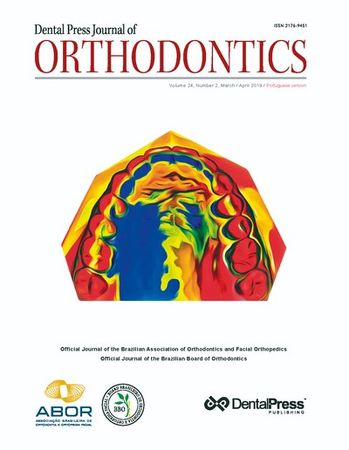
Seu carrinho está vazio!
Introduction: Genetics has been suggested as an explanation for the etiology of malocclusions, although some questions, due to the perception that genetic inheritance is tied to a monogenic or Mendelian form of inheritance. Objective: This paper describes the inheritance of malocclusions, highlighting the areas of knowledge where research has explored mechanisms that explain deviations in patterns of craniofacial growth. Conclusion: Malocclusions have a complex or multifactorial pattern of...



Even though contemporary orthodontics has broadened the age span for orthodontic treatment in adults, teenagers will always constitute a major portion of our patients. After all, as it is well known, orthodontic treatment by itself can only provide dramatic dentofacial changes during pubertal growth spurt, which may benefit our patients both in function and esthetics, and in the so-called psychosocial aspect.

This study contributes to the understanding of the mechanisms associated with signs and symptoms of tooth eruption, by investigating the presence of mast cells in pericoronal tissues during the intraosseous (Group 1) and submucosal (Group 2) phases of eruption. We compared findings for these two groups with each other and with those for the oral mucosa (Group 3). In each group, 14 specimens were analyzed microscopically after hematoxylin and eosin staining and immunohistochemical analysis of...

There are several yardsticks to gauge a man’s worth. One of them is, undoubtedly, the respect he earns from his peers. As I organizedthe questions to be sent to Professor David Normando, made by some of the greatest thinkers in the field of contemporaryOrthodontics, I saw the reflex of such respect on the profound inquiring, to which so few would be capable of responding withso much propriety. He has also proven that the stars that shine brightest in the celestial sphere are not restrict...

Objective: Orthodontic force application releases multiple enzymes in gingival crevicular fluid (GCF) for activation, resorption, reversal, deposition of osseous elements and extracellular matrix degradation. The current systematic review critically evaluated all existing evidence on enzymes in orthodontic tooth movement. Methods: Literature was searched with predetermined search strategy on electronic databases (PubMed, Scopus, Embase), along with hand search. Results: Initial search...

Objective: The aim of this study was to evaluate the effect of displacement patterns of the molar teeth in response todifferent asymmetric headgear loading using 3D finite element method.Methods: A series of twenty-five facebow with different left vs. right outer bow length and different expansion of left vs.right were designed. The non-favored side (right side) was shortened at intervals of 10 mm, and favored side (left side)was expanded 10 degree greater than right side and 5 degree...

Introduction: Various types of separators have been advocated, but the ideal separator should produce optimum separation with minimal pain and discomfort. Objective: The objective of this study was to evaluate and compare the amount of separation achieved by three different types of separators (Elastomeric, Kesling and Kansal), and to assess the associated pain and discomfort. Methods: A random single-blind split-mouth study was conducted on 108 patients seeking fixed orthodontic treatment,...

Objective: To investigate the effects of application of vibratory stimuli, using an electric toothbrush, on the rate of orthodontic tooth movement during maxillary canine retraction. Methods: A split-mouth study was conducted in 28 subjects (mean age = 20.8 years; ranging from 18 to 24 years) whose bilateral maxillary first premolars were extracted with subsequent canine retraction. On the Vibration side, light force (100 g) was applied to the canine for 90 days, in combination with...

Objective: The aim of this study was to compare the cephalometric changes in Class II division 1 malocclusion patients treated with Jones Jig appliance or with maxillary first premolar extractions. Methods: The sample consisted of 88 lateral cephalograms of 44 patients, divided into two groups. Group 1 consisted of 21 patients treated with Jones Jig appliance, with a mean initial age of 12.88 ± 1.23 years and final mean age of 17.18 ± 1.37 years, and a mean treatment time of 4.29 years....

Objective: This study investigated the effect of the condition of lubrication on the friction between brackets and NiTi archwires of different rounded cross-sections. Methods: Brackets (Roth, GAC) were affixed to a device connected to a universal testing machine into which segments of archwire were placed (NiTi, Nitinol, GAC) with cross-sections of 0.012-in, 0.016-in and 0.020-in. Once the wire was in the bracket slot, the following lubricants were applied: human saliva (HS: positive...

Introduction: Orthodontic treatment aims at oral health and restoration of function as main objectives, however, psychological and social effects end up being the main reason for the demand for treatment. Objective: To determine the association between the oral health-related quality of life (OHRQoL), the need for orthodontic treatment and bullying among Brazilian teenagers. Methods: This was a cross-sectional epidemiological study. To assess the malocclusion, the Dental Aesthetic Index was...

Historically, whether for research purposes or clinical monitoring, orthodontic evaluation of dental movements has beendone using plaster study models and two dimensional (2D) radiographs. However, new frontiers for the diagnosis, planningand outcome assessment of orthodontic treatments have arisen, due to the revolutionary digital tools which enable a threedimensional (3D) computerized analysis of dental movements by means of digital models. However, the software for 3Danalysis are often...

Copyright © 1998 - 2022 DentalGO | Todos Direitos Reservados. DentalGO é uma marca Dental Press